
Hi Everybody!!
Tonight a review of one of the tiniest birds in North America and how they are big 'pollinators' among birds. This is the ruby-throated Hummingbird. They stay here at the bird sanctuary from August to October and then migrate to Mexico, where they are for the winter. Next month, they will begin the trek back to N. America to nest and have their babies. These birds have more flying miles than any human. Anyway, where ever the birds go, they pollinate flowers so the blooms make fruits and seeds. I have shared information below from Wikipedia on Ruby-Throated Hummingbirds and Pollinators. A real humdinger of a Photo Blog! Enjoy!





https://plus.google.com/u/0/photos/117645114459863049265/albums/5927462128708297905

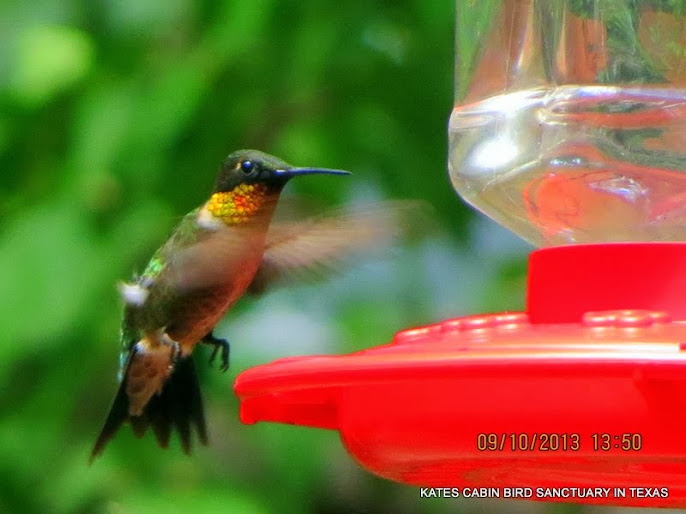

https://en.wikipedia.org/wiki/Ruby-throated_Hummingbird
Ruby-throated Hummingbird
From Wikipedia, the free encyclopedia
The Ruby-throated Hummingbird (Archilochus colubris) is a species ofhummingbird.
As with all hummingbirds, this species belongs to the family Trochilidae and is currently included in the order Apodiformes. This small animal is the only species of hummingbird that regularly nests east of the Mississippi River in North America.
| Ruby-Throated Hummingbird | |
|---|---|
 | |
| Conservation status | |
| Scientific classification | |
| Kingdom: | Animalia |
| Phylum: | Chordata |
| Class: | Aves |
| Order: | Apodiformes[2] |
| Family: | Trochilidae |
| Genus: | Archilochus |
| Species: | A. colubris |
| Binomial name | |
| Archilochus colubris (Linnaeus, 1758) | |
 | |
| Summer-only range Winter-only range Migratory path | |
Description[edit]
The Ruby-throated Hummingbird is the smallest bird species that breeds in theEastern United States and Eastern Canada. This hummingbird is from 7 to 9 cm (2.8 to 3.5 in) long and has a 8 to 11 cm (3.1 to 4.3 in) wingspan. Weight can range from 2 to 6 g (0.071 to 0.212 oz), with males averaging 3.4 g (0.12 oz) against the slightly larger female which averages 3.8 g (0.13 oz).[3][4] Adults are metallic green above and greyish white below, with near-black wings. Their bill, at up to 2 cm (0.79 in), is long, straight and very slender. As in all hummingbirds, the toes and feet of this species are quite small, with a middle toe of around 0.6 cm (0.24 in) and a tarsus of approximately 0.4 cm (0.16 in). The Ruby-throated Hummingbird can only fox-trot if it wants to move along a branch, though it can scratch its head and neck with its feet.[5][6]
The species is sexually dimorphic.[7] The adult male has a gorget (throat patch) of iridescent ruby red bordered narrowly with velvety black on the upper margin and a forked black tail with a faint violet sheen. The red iridescence is highly directional and appears dull black from many angles. The female has a notched tail with outer feathers banded in green, black, and white and a red throat that may be plain or lightly marked with dusky streaks or stipples. Males are smaller than females and have slightly shorter bills. Juvenile males resemble adult females, though usually with heavier throat markings.[8] The plumage is molted once a year, beginning in late summer.
Habitat and range[edit]
The breeding habitat is throughout most ofeastern North America and the Canadianprairies, in deciduous and pine forests and forest edges, orchards, and gardens. The female builds a nest in a protected location in a shrub or a tree. Of all hummingbirds in theUnited States, this species has the largest breeding range.[5]
The Ruby-throated Hummingbird is migratory, spending most of the winter in southernMexico and Central America, as far south as extreme western Panama,[9] and the West Indies. It breeds throughout the eastern United States, east of the 100th meridian, and in southern Canada in eastern and mixed deciduous forest.[10] In winter, it is seen mostly in Mexico.
Behavior[edit]
Ruby-throated Hummingbirds are solitary. Adults of this species are not social, other than during courtship (which lasts a few minutes); the female also cares for her offspring. Both males and females of any age are aggressive towards other hummingbirds. They may defend territories, such as a feeding territory, attacking and chasing other hummingbirds that enter.
As part of their spring migration, portions of the population fly across the Gulf of Mexico. This feat is impressive, as a 800 km (500 mi), non-stop flight over water would seemingly require a caloric energy that far exceeds an adult hummingbird's body weight of 3 g (0.11 oz). However, researchers discovered the tiny birds can double their lean mass in preparation for their Gulf crossing. The additional mass, stored as fat, provides enough energy for the birds to achieve the flight.
They feed frequently while active during the day. When temperatures drop, particularly on cold nights, they may conserve energy by entering hypothermic torpor.
Flight[edit]
Hummingbirds have many skeletal and flight muscle adaptations which allow the bird great agility in flight. Muscles make up 25–30% of their body weight, and they have long, blade-like wings that, unlike the wings of other birds, connect to the body only from the shoulder joint. This adaptation allows the wing to rotate almost 180°, enabling the bird to fly not only forward but fly backwards, and to hover in front of flowers as it feeds on nectar, or hovers mid-air to catch tiny insects. Hummingbirds are the only known birds that can fly backwards.
During hovering, (and likely other modes of flight) ruby-throated hummingbird wings beat 55 times per second.
Diet[edit]
Nectar from flowers and flowering trees, as well as small insects and spiders, are its main food. Although hummingbirds are well known to feed on nectar, small arthropods are an important source part of protein, minerals, and vitamins in the diet of adult hummingbirds. Hummingbirds show a slight preference for red, orange, and bright pinktubular flowers as nectar sources, though flowers not adapted to hummingbird pollination(e.g., willow catkins) are also visited.[9] Their diet may also occasionally include sugar-rich tree sap taken from sapsucker wells. The birds feed from flowers using a long extendable tongue, and catch insects on the wing or glean them from flowers, leaves, bark, and spiders' webs.
Young birds are fed insects for protein since nectar is an insufficient source of protein for the growing birds.[9]
Reproduction[edit]
As typical for their family, Ruby-throated hummingbirds are thought to be polygynous. Polyandry and polygynandry may also occur. They do not form breeding pairs, with males departing immediately after the reproductive act and females provide all parental care.[11]
Males arrive at the breeding area in the spring, and establish a territory before the females arrive. When the females return, males court females that enter their territory by performing courtship displays. They perform a “dive display” rising 2.45–3.1 m (8.0–10.2 ft) above and 1.52–1.82 m (5.0–6.0 ft) to each side of the female. If the female perches, the male begins flying in very rapid horizontalarcs less than 0.5 m (1.6 ft) in front of her. If the female is receptive to the male, she may give a call and assume a solicitous posture with her tail feathers cocked and her wings drooped.
The nest is usually constructed on a small, downward-sloping tree limb 3.1 to 12.2 m (10 to 40 ft) feet above the ground. Favored trees are usually deciduous, such as oak, hornbeam, birch, poplar or hackberry, although pines have also been used. Nests have even been found on loops of chain, wire, and extension cords.[5] The nest is composed of bud scales, with lichen on the exterior, bound with spider's silk, and lined with fibers such as plant down (often dandelion or thistle down) and animal hair. Most nests are well camouflaged. Old nests may be occupied for several seasons, but are repaired annually.[9] As in all known hummingbird species, the female alone constructs the nest and cares for the eggs and young.
Females lay two (with a range of 1 to 3) white eggs about 12.9 mm × 8.5 mm (0.51 in × 0.33 in) in size, and produce one to two broods each summer.[5] They brood the chicks over a period of 12 to 14 days, by which point they are feathered and homeothermic. The female feeds the chicks from 1 to 3 times every hour by regurgitation, usually while the female continues hovering. When they are 18 to 22 days old, the young leave the nest and make their first flight.[9]
Longevity and mortality[edit]
The oldest known Ruby-throated Hummingbird to be banded was 9 years and 1 month of age. Almost all hummingbirds of 7 years or more in age are females, with males rarely surviving past 5 years of age. Reasons for higher mortality in males may include loss of weight during the breeding season due to the high energetic demands of defending a territory followed by energetically costly migration. A variety of animals prey on hummingbirds given the opportunity. Due to their small size, hummingbirds are vulnerable even to birds and other animals which generally feed on insects. Chief among their predators are Sharp-shinned Hawks, domestic cats andloggerhead shrikes, all of which are likely to ambush the hummingbird while it sits on a perch. Bird-eating lizards and snakes may also prey on the species, especially on its tropical wintering grounds. Also largemouth bass,bullfrogs and green frogs have reportedly grabbed hummingbirds approaching water in an attempt to drink or bathe. Even large, predaceousinvertebrates have preyed on Ruby-throated Hummingbirds, includingpraying mantises, orb-weaver spiders and Green Darners. Blue jays are common predators of nests.[12][13][14]




Back Porch at Kates Cabin

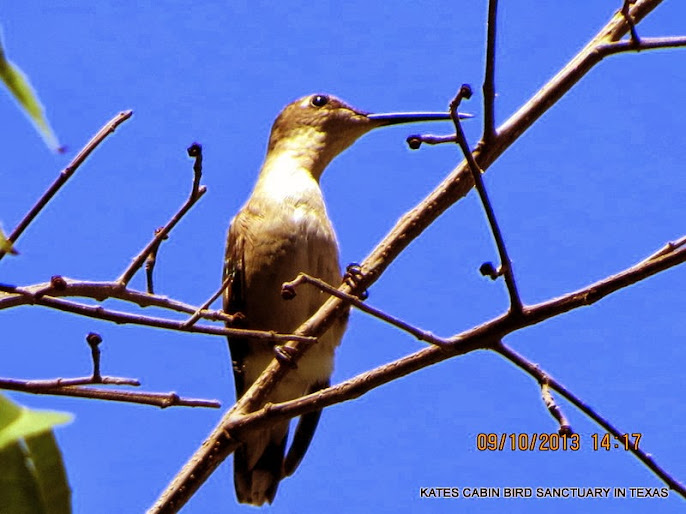
https://en.wikipedia.org/wiki/Pollinator
Pollinator
From Wikipedia, the free encyclopedia

A syrphid fly (Eristalinus taeniops) pollinating a common hawkweed
Background[edit]
Plants fall into pollination syndromes that reflect the type of pollinator being attracted. These are characteristics such as: overall flower size, the depth and width of the corolla, the color (including patterns called nectar guides that are visible only in ultravioletlight), the scent, amount of nectar, composition of nectar, etc.[1] For example, birds visit red flowers with long, narrow tubes and lots of nectar, but are not as strongly attracted to wide flowers with little nectar and copious pollen, which are more attractive to beetles. When these characteristics are experimentally modified (altering colour, size, orientation), pollinator visitation may decline.[2][3]
Types of pollinators[edit]
Bees[edit]
The most recognized pollinators are the various species of bees, which are plainly adapted to pollination. Bees typically are fuzzy and carry an electrostatic charge. Both features help pollen grains adhere to their bodies, but they also have specialized pollen-carrying structures; in most bees, this takes the form of a structure known as the scopa, which is on the hind legs of most bees, and/or the lower abdomen (e.g., ofmegachilid bees), made up of thick, plumose setae. Honey bees, bumblebees, and their relatives do not have a scopa, but the hind leg is modified into a structure called the corbicula (also known as the "pollen basket"). Most bees gather nectar, a concentrated energy source, and pollen, which is high protein food, to nurture their young, and inadvertently transfer some among the flowers as they are working.Euglossine bees pollinate orchids, but these are male bees collecting floral scents rather than females gathering nectar or pollen. Female orchid bees act as pollinators, but of flowers other than orchids. Eusocial bees such as honey bees need an abundant and steady pollen source to multiply.
Honey bees[edit]
Honey bees travel from flower to flower, collecting nectar (later converted to honey), and pollen grains. The bee collects the pollen by rubbing against the anthers. The pollen collects on the hind legs, in a structure referred to as a "pollen basket". As the bee flies from flower to flower, some of the pollen grains are transferred onto the stigma of other flowers.
Nectar provides the energy for bee nutrition; pollen provides the protein. When bees are rearing large quantities of brood (beekeepers say hives are "building"), bees deliberately gather pollen to meet the nutritional needs of the brood. A honey bee that is deliberately gathering pollen is up to 10 times more efficient as a pollinator than one that is primarily gathering nectar and only unintentionally transferring pollen.
Good pollination management seeks to have bees in a "building" state during the bloom period of the crop, thus requiring them to gather pollen, and making them more efficient pollinators. Thus, the management techniques of a beekeeper providing pollination services are different from, and to some extent in tension with, those of a beekeeper who is trying to produce honey.
Millions of hives of honey bees are contracted out as pollinators by beekeepers, and honey bees are by far the most important commercial pollinating agents, but many other kinds of pollinators, from blue bottle flies, to bumblebees, orchard mason bees, and leaf cutter bees are cultured and sold for managed pollination.
Other species of bees differ in various details of their behavior and pollen-gathering habits, and honey bees are not native to the Western Hemisphere; all pollination of native plants in the Americas historically has been performed by various native bees.
Hoverflies[edit]
Main article: Hoverflies
Syrphid flies, such as hoverflies and drone flies, are an extremely variable family of flies that range from large, bulky, and hairy to the small, slender, and shiny. Many larvae of hoverfly species are important controls of aphids, while adults feed on nectar and pollen. Hoverflies are important pollinators of flowering plants worldwide.[4] Often hoverflies are considered to be the second most important pollinators after wild bees.[4] Although hoveflies as a whole are generally considered to be nonselective pollinators, some species have more specialized relationships. The orchid speciesEpipactis veratrifolia mimics alarm pheromones of aphids to attract hover flies for pollination.[5] Another plant, the slipper orchid in southwest China, also achieves pollination by deceit by exploiting the innate yellow colour preference of syrphide.[6]
Other insects[edit]
Many insects other than bees accomplish pollination by visiting flowers for nectar or pollen, or commonly both. Many do so adventitiously, but the most important pollinators are specialists for at least parts of their lifecycles for at least certain functions. For example, males of many species of Hymenoptera, including many hunting wasps, rely on freely flowering plants as sources of energy (in the form of nectar) and also as territories for meeting fertile females that visit the flowers. Prominent examples are predatory wasps (especially Sphecidae, Vespidae, andPompilidae). The term "pollen wasps", in particular, is widely applied to the Masarinae, a subfamily of the Vespidae; they are remarkable among solitary wasps in that they specialise in gathering pollen for feeding their larvae, carried internally and regurgitated into a mud chamber prior to oviposition.
Many bee flies, and some Tabanidae and Nemestrinidae are particularly adapted to pollinating fynbos and Karoo plants with narrow, deep corolla tubes, such asLapeirousia species. Part of the adaptation takes the form of remarkably long probosces.
Lepidoptera (butterflies and moths) also pollinate plants to various degrees.[7] They are not major pollinators of food crops, but various moths are important pollinators of other commercial crops such as tobacco. Pollination by certain moths may be important, however, or even crucial, for some wildflowers mutually adapted to specialist pollinators. Spectacular examples include orchids such as Angraecum sesquipedale, dependant on a particular hawk moth, Morgan's sphinx. Yucca species provide other examples, being fertilised in elaborate ecological interactions with particular species of yucca moths.
Beetles of species that specialise in eating pollen, nectar, or flowers themselves, are important cross-pollinators of some plants such as members of the Araceae and Zamiaceae, that produce prodigious amounts of pollen. Others, for example the Hopliini, specialise in free-flowering species of the Asteraceae and Aizoaceae.
Various midges and thrips are comparatively minor opportunist pollinators. Ants also pollinate some kinds of flowers, but for the most part they are parasites, robbing nectar without conveying useful amounts of pollen to a stigma. Whole groups of plants, such as certain fynbos Moraea and Erica species produce flowers on sticky peduncles or with sticky corolla tubes that only permit access to flying pollinators, whether bird, bat, or insect.
Carrion flies and flesh flies in families such as Calliphoridae and Sarcophagidae are important for some species of plants whose flowers exude a fetid odor. The plants' ecological strategy varies; several species of Stapelia, for example, attract carrion flies that futilely lay their eggs on the flower, where their larvae promptly starve for lack of carrion. Other species do decay rapidly after ripening, and offer the visiting insects large masses of food, as well as pollen and sometimes seed to carry off when they leave.
Some male Bactrocera fruit flies are exclusive pollinators of some wild Bulbophyllum orchids that lack nectar and have a specific chemical attractant and reward (methyl eugenol, raspberry ketone or zingerone) present in their floral fragrances.[8][9][10]
A class of strategy of great biological interest is that of sexual deception, where plants, generally orchids, produce remarkably complex combinations of pheromonal attractants and physical mimicry that induce male bees or wasps to attempt to mate with them, conveying pollinia in the process. Examples are known from all continents apart from Antarctica, though Australia appears to be exceptionally rich in examples.[11]
Some Diptera (flies) may be the main pollinators at higher elevations of mountains, whereas Bombus species are the only pollinators among Apoidea in alpine regions at timberline and beyond.
Other insect orders are rarely pollinators, and then typically only incidentally (e.g., Hemiptera such as Anthocoridae and Miridae).
Vertebrates[edit]
Bats are important pollinators of some tropical flowers. Birds, particularly hummingbirds, honeyeaters and sunbirds also accomplish much pollination, especially of deep-throated flowers. Other vertebrates, such as monkeys, lemurs, possums, rodents and lizards[12]have been recorded pollinating some plants.
Humans can be pollinators, as many gardeners have discovered that they must hand pollinate garden vegetables, whether because of pollinator decline (as has been occurring in parts of the U.S. since the mid-20th century) or simply to keep a strain genetically pure. This can involve using a small brush or cotton swab to move pollen, or to simply tap or shake tomato blossoms to release the pollen for the self pollinating flowers. Tomato blossoms are self-fertile, but (with the exception of potato-leaf varieties) have the pollen inside the anther, and the flower requires shaking to release the pollen through pores. This can be done by wind, by humans, or by asonicating bee (one that vibrates its wing muscles while perched on the flower), such as a bumblebee. Sonicating bees are extremely efficient pollinators of tomatoes, and colonies of bumblebees are quickly replacing humans as the primary pollinators forgreenhouse tomatoes.
Pollinator population declines and conservation[edit]
Pollinators provide a key ecosystem service vital to the maintenance of both wild and agricultural plant communities. In 1999 the Convention on Biological Diversity issued the São Paulo Declaration on Pollinators, recognizing the critical role that these species play in supporting and maintaining terrestrial productivity as well as the survival challenges they face due to anthropogenic change. Today pollinators are considered to be in a state of decline;[13] some species, such as Franklin’s bumble bee (Bombus franklini) have been red-listed and are in danger of extinction. Although managed bee hives are increasing worldwide, these can not compensate for the loss of wild pollinators in many locations.
Declines in the health and population of pollinators pose what could be a significant threat to the integrity of biodiversity, to global food webs, and to human health. At least 80% of our world's crop species require pollination to set seed. An estimated one out of every three bites of food comes to us through the work of animal pollinators. The quality of pollinator service has declined over time and this had led to concerns that pollination will be less resistant to extinction in the future.
Moms Memory Garden where hummingbirds spend the night when they are here:

...this is brendasue signing off from Rainbow Creek. See You next time!
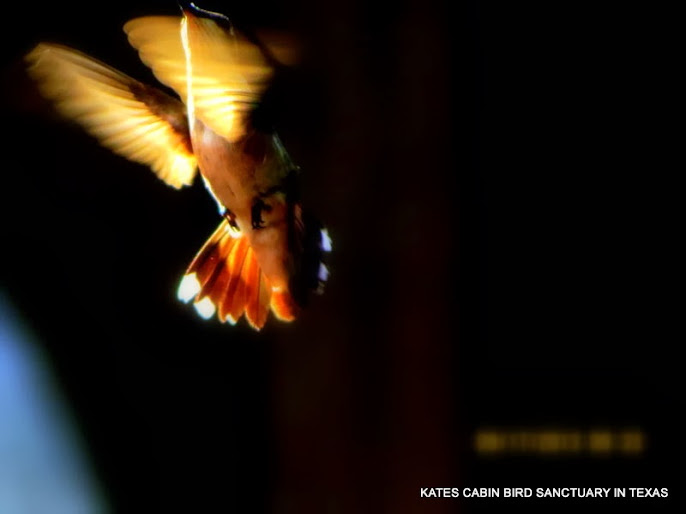
O+O


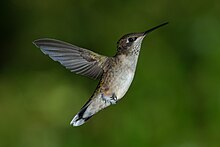
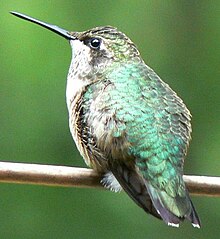

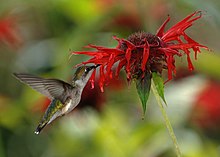






No comments:
Post a Comment
Hi Everybody! Please say hello and follow so I know you are here! Due to the inconsideration of people trying to put commercials on my blog comment area, I have restricted use of anonymous posts. Sorry that some hurt all.
My public email is katescabin@gmail.com No spammers or trolls